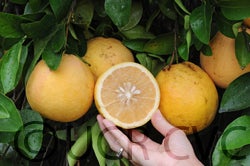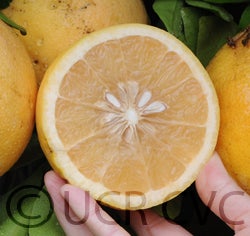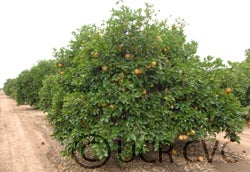Citrus paradisi Macfadyen
CRC 1198
PI 539460
Source
Received as budwood from George Roeding Nurseries, 1919
Parentage/origins
Originated as a limb sport in a tree of the Walters variety in an orchard near Ellenton, Florida, by R.B. Foster in 1907.
Rootstocks of accession
Carrizo citrange, C-35 citrange
Season of ripeness at Riverside
January to May
Notes and observations:
3/18/1988, EMN: Very seedy; faint pink tinge in flesh; perhaps even lighter pink color than Redblush.
5/29/2009, DK & TS: Very light blush, seedy. Good flavor, with balance of sweet and tart.
Description from The Citrus Industry Vol. 1 (1967):
"Fruit medium-large, oblate to spherical; basal furrows short, radiating; areolar ring indistinct; very seedy. Primary color pale to light yellow, but under favorable conditions rind blushed with pink, extending into the albedo. Rind medium-thick and surface smooth. Primary flesh color chamois, but under favorable conditions pink; flesh texture tender and juicy; flavor good. Medium-early in maturity.
Tree vigorous, large, and productive.
This variety originated as a limb sport in a tree of the Walters variety in an orchard near Ellenton, Florida, and was discovered in 1907 by R. B. Foster of nearby Manatee. It was introduced in 1914 by the Royal Palms Nurseries, Oneco.
Foster is of horticultural interest primarily because it is the first pigmented grapefruit variety of record in Florida. As such, it attracted considerable attention and was planted to a limited extent both in Florida and Texas. With the advent of the seedless pink-fleshed Thompson variety only ten years later, however, interest in Foster declined abruptly and it has not been planted for many years.
Another reason for horticultural interest in this variety is the fact that in Texas it gave rise by bud mutation to the seedless pink-fleshed variety, Foster Seedless, which closely resembles Thompson but exhibits somewhat better flesh coloration. Nucellar seedlings of Foster also possess more intense pigmentation than the parent clone."
Availability
Not commercially available in California.
USDA Germplasm Resources Information Network page for Foster Pink grapefruit



